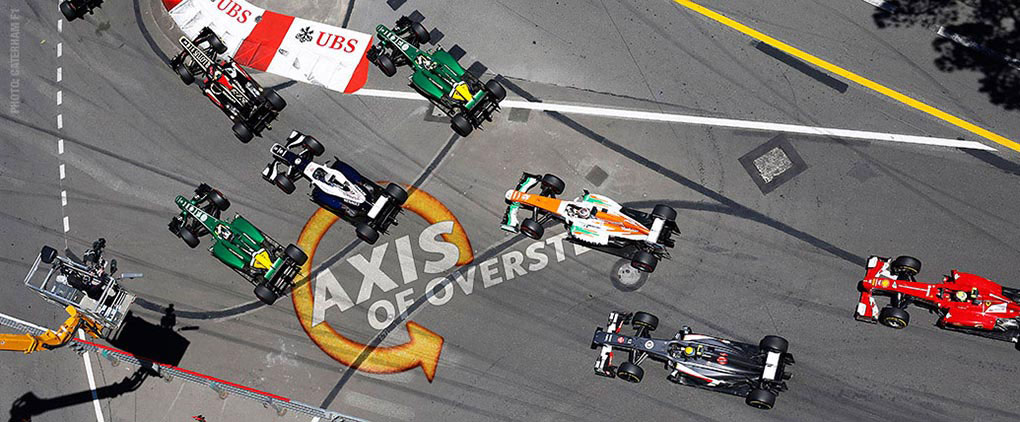The Belgian GP was not not especially spectacular to watch on TV. The drag down to and up Eau Rouge between Alonso and Hamilton was great to watch but after the first 3 corners it was essentially all over.
So, let's look at these two videos, rarely seen on TV and showing some more esoteric (or geekier...you pick) aspects of F1: Flexi-wings and Launch Control...(yeah, I know it's not supposed to exist).
By now we are familiar with the concept of flexible wings as used in F1, a brilliant way to get around the limitation on movable aero-devices. This video of Fisichella's Renault very clearly illustrates the principle. You see the angle of attack of the lower rear element on the front wing change with speed very clearly. You can also see that there is some instability in the element, no way to know if something is broken or just not working right but that same element bounces up an down when the car rides curbs, that cannot be good for aero grip and I wonder if it's what causes Giancarlo to lift a touch the fist time going through Eau Rouge.
As an aside...why not allow use of movable front wings in passing situations to counter the washout effect of following other cars closely? Any aerodynamicists out there?
In the second video, practice starts, first Jarno Trulli in the Toyota then Felipe Massa in the Ferrari. Aside from the fact that the Toyota has it's clutch lever on the left side and the Ferrari on the right, it sounds like they use quite a different traction control strategy, listen

i thought the clutch lever is on both sides?
ReplyDeleteWow - looking out the rear of Fisi's car through Eau Rouge is sensational.
ReplyDeleteJulian
ReplyDeleteI thought so too, I think also that looking out the back really gives a great sense of both speed and elevation change, I have a clip shot from the rear of my car going up the "esses" at Watkins Glen where it looks quite impressive even at the relatively slow 100mph or so speed. No surprise it's a great shot at F1 speeds!
Anonymous
It may be...maybe Jarno is left handed!
Hello,
ReplyDeleteAs you allow for more flexibility in the wing, the aero-elastic effects increase.
There's a phenomenon called divergence.
The lift(downforce here) is produced at a certain rate , a certain frequency and each time the lift varies the loads on the wing do the same.
That means the aerodynamic frequency (the rate of change) is translated into a rigid frequency (a vibration).
Each material as a frequency were it transfers energy between particules, and on normal condition the frequency coming from aero loads is close to the natural frequency of the material, thus the material dampers the loads.
But if the lift is produced too fast (higher speeds or fast load changes like on a kerb) the loads coming from the lift overdrive the material damping possibilities and we enter into a very dangerous area where the load from the wing actually add energy into the material, which means the vibrations in the materials increase on and on and on and on..
In those conditions, a critical parameter is the stiffness and another is the torsional geometry but i won't enter into details.
The outcome of this can be desastrous and you've seen it already, it is the abrupt and without any warning breaking of the wings.
Wing divergence due to high speed is dangerous because the high speeds are maintained.
On kerbs however it is not because as soon as you leave the kerb there's no problems anymore.
Now one thing to get is that seeing a wing moving is not necessarily bad, if we were to take the geometry of a kerb, to get the best grip on it a wing should be flexible to adapt.
The real bad thing is when a wing vibrate at an increasing frequency...that's really a bad sign.
As for turbulence, the overtaking working group is working for 2009 on a larger front wing.
The chord of the wing will be longer so that less angle of attack will be required.(the more angle of attack the more sensible to loads variations)
In addition the rear wing and diffuser (both responsible for unstable vortex) will be reshaped.
in 2011 the wings will be closer to the ground because when they are closer they're less sensitive too.
In a way to put it simple: we are nowadays in a optimization process, this means we go at the edge of an existing system.
The result is that everything is sensible to the slightest detail.
Towards 2009 we will go into an evolution process which means new systems but less aggressive.
If any questions, corrections, don't hesitate.
Thank you Ogami.
ReplyDeleteInstinctively, I get the impression vibrations like the ones you see first time through Eau Rouge in the video cannot be "right" especially considering the care that is take with every single aero profile on the car...
interesting about the future regs.